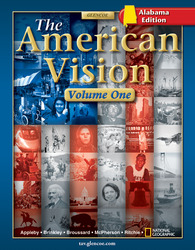The American Vision Volume 1, Alabama EditionChapter 9:
Manifest Destiny, 1835—1848Web Lesson PlansIntroduction
Students have read about the westward movement of settlers in the 1840s. In this activity they will discover how the settlers survived the journey and what challenges they faced along the Oregon Trail.
Lesson Description
Students will use information from the Oregon Trail Web site to learn about life along the trail for settlers in the 1800s. They will read the diary of a missionary woman who headed west along the trail in 1836. They will also explore the site to find background information about the trail, view video clips of historians talking about the migration, and take a virtual trip to see sites along the trail. Students will then answer four questions and apply this information by creating a picture storybook for young children that tells the story of westward migration along the Oregon Trail.
Instructional Objectives- Students will summarize the experiences and challenges of settlers who headed west in the 1840s along the Oregon Trail.
- Students will be able to use this knowledge to create a picture storybook for young children that tells the story of westward migration along the Oregon Trail.
Student Web Activity Answers- The Whitman party included three other missionaries, three Native American boys, and two men to "assist in packing animals." All of their possessions were packed in one wagon, and they traveled in another. Along with their possessions, they took 14 horses, 6 mules, and 15 head of cattle. They traveled with the Fur Company, which had 400 animals, 70 men, and 7 wagons.
- The Whitmans were traveling with three Native American boys for whom Mrs. Whitman expressed fondness. Along the trail, Native Americans welcomed the settlers, shared their food with them, and marveled at the site of white women. In one instance, Native American women came to greet Mrs. Whitman, shaking her hand and kissing her. The Native Americans thanked Mrs. Whitman and her group for coming to their land.
- Each morning around eleven o'clock and each evening around six o'clock, the settlers set up camp. An India rubber cloth was thrown on the ground and topped with a cotton cloth. Sitting on the ground, the settlers set their places with plates, knives, forks, and tin cups. Dried buffalo dung served as fuel for the fire, as there was no wood on the prairie. At night the settlers would form a large ring with baggage, tents, and wagons along the outside, and most of the animals within the circle. Blankets, placed over the rubber cloth, served as their bed and bedding. At first, their meals included milk, tea, bread, and buffalo meat. At times their only sustenance was buffalo meat and tea, served three times a day. Further west, they were able to find fish, antelope, elk, and salmon.
- The settlers faced challenges each day on the trail. The trail was physically demanding, and when there was water to cross, there was the danger of slipping or drowning. Mrs. Whitman recorded that several times people in the party were sick. They had no doctor and had to rely on their own cures. There were times when they had to be wary of unfriendly Native Americans, such as the "Blackfeet." While they always had buffalo meat, they had little else to eat. Mrs. Whitman also faced the challenge of being homesick, missing her friends, and being uncertain of her future.
- Students' storybooks will vary.
 |  |







